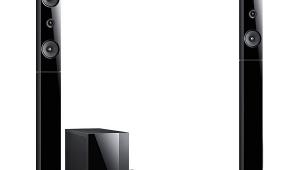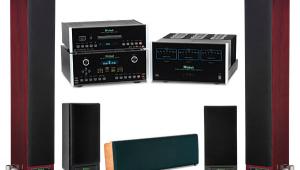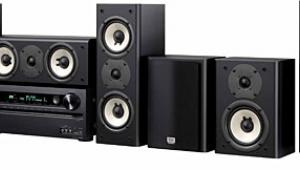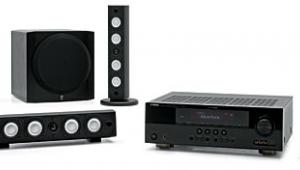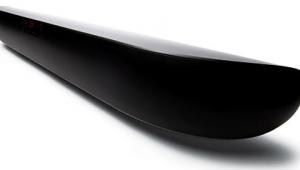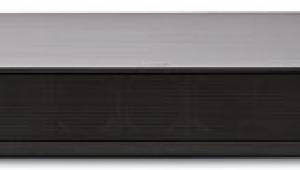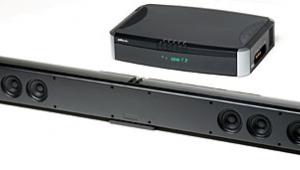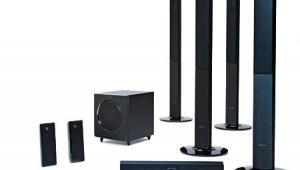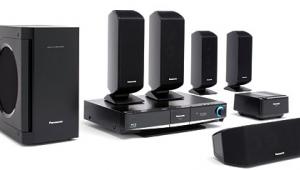ZVOX 425 Speaker System
Some people would call it cheating. Others might be less pejorative and consider it a shortcut. Either way, setting a rectangular box on top of your TV, plugging in an analog stereo RCA cable, finding an outlet for a single AC power cord, and pressing the power button isn’t what God intended when he gave us home theater. No, a real man’s home theater demands a separate processor and amplifiers, multiple speakers, many long runs of speaker wire, and an inconvenient place to put a subwoofer. It should take real work to set the whole thing up—and more than a sporting chance to wire something incorrectly.
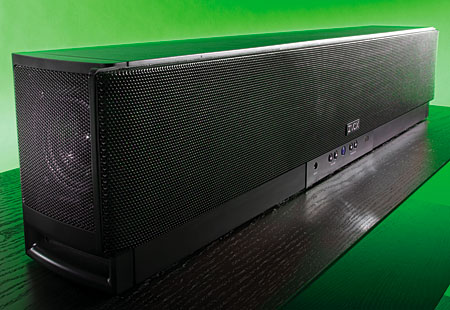
So it makes me uneasy when I read that the new ZVOX 425 is “the world’s first full-range, wall-mount single-cabinet home theater with built-in subwoofers” and that it “requires only one connecting cord.” But I recently moved into a new house in which I’m temporarily making do with a much smaller home theater room than I’m used to. It’s given me an appreciation for these single-cabinet surround sound thingamabobs. Other than a full-blown custom-installed system, this singular-sensation concept may be the only way to properly feng shui your home theater in a cramped room. (It’s my understanding that THX is working on a feng shui spec, but don’t quote me on that.)
The Basics
When it comes to room space, the new ZVOX 425 doesn’t demand much. The entire system consists of a basic rectangular box that’s about 3 feet in width, and half a foot (give or take an inch) in both height and depth. A metal grille spans the entire front of the cabinet and extends approximately an inch off of each side. Just below the grille is a narrow black strip with the buttons for power on/off, volume, and PhaseCue up/down, as well as a 3.5mm input jack. Inset along the back and bottom is a connection panel with two sets of stereo analog audio inputs, a stereo analog output, a master power button, and the socket for the power cord. There’s also a knob for adjusting ZVOX’s S.A.N.E. (That’s Sudden Audio Noise Eliminator or, in layman’s terms, an audio-compression circuit that’s primarily meant for use during late-night movie watching.) In addition to the fact that the connections are easier to reach than those on most wall-mountable systems, the silk-screened labels are printed upside down—which means they’ll be right side up when you lean over the top of the cabinet and look down at the jack panel.
Clear vinyl disc pads on the 425’s bottom keep it from scratching the top of the TV it’s sitting on or vibrating its way off said TV and onto the floor. (The MDF cabinet construction is nice, but it’s not going to survive that kind of drop test.) There are four grommets on the back in case you decide to opt for the optional wall bracket. ZVOX didn’t send a bracket along with the 425, so I don’t have first-hand experience with installing it on the wall. At 25 pounds, though, the 425 isn’t likely to pull the studs out of your wall if you choose to go that route.

Behind the front grille are five 3.25-inch full-range drivers, two of which are controlled by ZVOX’s PhaseCue virtual surround circuitry. Mounted on each side of the cabinet are 4-inch powered subwoofers with side-firing ports. OK, really, I can’t call them “subwoofers,” even if ZVOX does. Nor am I willing to believe that they’re capable of low frequencies down to 35 hertz, as ZVOX claims—at least not audibly. Let’s call them low-frequency drivers and leave it at that. Metal grilles that match the one on the front of the cabinet cover the drivers, but not the ports.
Setup, as I alluded to earlier, is blessedly simple, with a mere three steps from silence to sound. 1) Connect an analog stereo audio cord from your TV’s audio output to the Input 1 jack. 2) Plug in the AC power cord. 3) Turn on the main power button. You’ll probably have to rest at this point, but breathe deep, and you’ll be fine. (Wall-mounting, of course, is a bit more involved.)
PhaseCue
The big test, of course, is how well it can fill a room with sound and surround. The 425 lacks discrete surround speakers and instead uses virtual surround processing, called PhaseCue. To achieve its sleight of ear, the processing manipulates the phase of the left- and right-channel signals, then sends varying versions of the signals to separate drivers in the cabinet. Unlike Dolby Digital and DTS, though, PhaseCue doesn’t utilize discretely encoded signals to create the surround effect. Instead, it bases its processing on spatial cues that are present in the analog audio signal. The program material, as a result, can make a big difference in how well—subjectively—the processing performs. To help accommodate for this, the system includes a nine-step PhaseCue processing level adjustment.
As I listened to the ZVOX 425, the first thing that I (and several others) noticed was the substantial amount of bass the system reproduced. All right, this isn’t wisdom-tooth-extracting, turn-your-innards-into-liver-flavored-gelatin bass, but it is more than you’d expect at first glance—and quite satisfying for a small system like this. It’s also noteworthy that, even with the system’s bass-level control at maximum, there was minimal distortion in the bottom end.
I hadn’t had much previous experience with ZVOX systems, so I wasn’t sure what to expect from the PhaseCue processing. The simplest way to explain the effect is to imagine a small pair of speakers that gradually grow larger and farther apart as the PhaseCue level increases until, at the maximum processing level, there’s a soundstage that forms a semicircle around the listener. In my listening tests, a large semicircular bubble of sound was about as good as it got. I never had the sensation that sound was coming from behind me, to be sure, but there were times when the edge of the soundfield seemed as if it stopped in the middle of my head.
Music and Movies
In Casino Royale, in one of the early obligatory chase scenes as Bond and his quarry are dodging significant amounts of gunfire, several of the flying bullets seemed to find their way in one of my ears and out the other. Similarly, near the end of Peter Pan (the 2003 version and my daughter’s current favorite movie), many of Pan’s and Hook’s flying stabs and swoops seemed to detour right through my skull—an effect similar to what you might experience if you were wearing headphones for the surround channels. If you’re expecting discrete 5.1-channel performance, you’ll be disappointed; but if you’re cognizant of the trade-offs this speaker makes for sizing and simplicity, you might find the effect kind of cool.
While it is easy to set-and-forget the PhaseCue level with movies, music is a little more problematic because variations in post-production processing of studio recordings can make a huge difference in the level of PhaseCue that’s appropriate. When I turned the PhaseCue level above four on Lyle Lovett’s Road to Ensenada CD, the 425 exaggerated the reverb already present in the recording so much that I needed the remote control close at hand to avoid clawing my eardrums out with my fingernails. On the other hand, a higher level of PhaseCue emphasized the smooth sweetness of a more natural recording like “Cry Me a River” from the Ray Brown Trio’s Soular Energy disc. But even with the relatively simple mix on John Gorka’s Writing in the Margins CD, I found that adding too much PhaseCue stretched and smeared the acoustic guitar and vocals. I wound up using PhaseCue level settings of anywhere from four to seven of the nine available. With some recordings, even one level of adjustment up or down made a big difference in performance. Movies, on the other hand, almost always sounded good at a setting two or three levels below the maximum.
On a note unrelated to the virtual surround, the system did strain a bit with lower male voices like Gorka’s and Lovett’s, but that’s not unusual with center-channel speakers in $700-and-under HTIB systems. In terms of overall performance compared with those systems, it’s a difficult call.
Conclusion
There’s no doubt you can find a similarly priced HTIB that will offer better 5.1-channel separation and localization, more inputs, and the option of upgrading the system at a later date. That’s not what the ZVOX 425 is about, and it will disappoint you on those counts. On the other hand, if you’re looking for something simple and automatic to hang on the wall with a flat-panel TV, or you have to recommend a system to a relative or friend who will call you for help whenever he or she can’t figure out how to operate the system, this one should be on your short(cut) list.
Highlights
Auto on/off requires virtually no brainpower from the user
Front-mounted mini-jack input overrides the main input source
Virtual surround-effect level is adjustable
